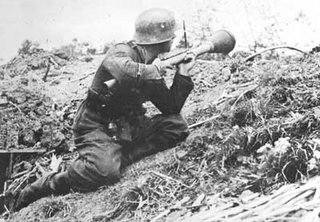Slat.

This is coolbert:
Here is a blast from the past. Or rather, an anti-blast from the past.
Slat armor. Funny looking stuff that is used as an enhancement for vehicles that are already armored.
Armor specifically designed to defeat the shaped charge anti-tank [armor] warhead. The warhead [high explosive anti-tank [HEAT]] that is fired from such weapons as the rocket propelled grenade [RPG] so commonly used against American forces in Iraq.
The shaped charge. First used in that fiendishly clever and effective German anti-tank weapon, the Panzerfaust. Allowed the average infantryman, a man-a-foot, to defend himself against tank attack.

Also used in anti-tank guided missiles of the Sagger backpack variety. In the below photo, apparently being set-up by Vietnamese troops.

When impacting with the armor of a tank or other armored vehicle, the shaped charge gives off a pencil thin jet of extremely hot gas. A gas so hot it melts it's way through the thickest armor. Killing the tank crew, setting off detonations of tank ammo or fuel, and generally causing very dramatic mayhem to the mechanism of the tank.
Slat armor defeats the HEAT round in that it prematurely detonates the warhead of the RPG or similar weapon. This premature detonation dissipates the pencil thin jet of gas, and the effect of the weapon is much mitigated. Is not 100 % effective, but is effective to a large degree.
Slat armor, when installed, creates a bird cage type appearance. Is strange looking. But the intent is effectiveness, not aesthetics.
First was used in an expedient mode. Such as found on World War Two [WW2] Soviet T-34 tanks. Bedsprings were mounted on sensitive parts of the tank. Again, looks strange, but is effective. [look closely at the turret of the T-34 in the below picture and you will see the expedient slat armor.]

A form of slat armor was also used by U.S. forces in Vietnam. The M577 armored personnel carrier [APC] was used by some U.S. units as a command vehicle. The flat sides of the APC made a very tempting target for enemy gunners wielding a RPG. To counter this form of attack in laager [encampment], the APC would be surrounded by a RPG barrier made of chain link fence. The fence, when hit, would prematurely detonate and defeat the warhead of the RPG. When breaking camp, the chain link fence would be rolled up and hung from the flat sides of the APC, affording protection during movement. See the below picture for the rolled up lengths of chain link fence being hung from the sides of the APC.

And with the widespread use of RPG type weapons in Iraq, it seems that slat armor is enjoying a bigtime comeback. Currently being retrofitted on a variety of U.S. armored vehicles, to include the Stryker, and the old fashioned M113 armored personnel carrier [APC].

[the M113 was never intended to be used in combat again. Was supposed to be totally replaced by the Stryker. The dire need for armor has necessitated the deployment of the M113. It was felt decades ago, thanks to bad experience in Vietnam, that the RPG type weapon made a death trap for troops inside the M113. It seems that slat armor has breathed new life into an old vehicle. The Super-Gavin M113 with slat armor and a turret type of mount seems to be the current weapon of choice in Iraq!!]
And the stuff works. Is appreciated by militaries all over the world. Even the Russians have an apparatus they can mount on their answer to the Stryker, the Russian BTR-80.

As I have said many times before. The old ways are quite often the best ways.
coolbert.

0 Comments:
Post a Comment
Subscribe to Post Comments [Atom]
<< Home